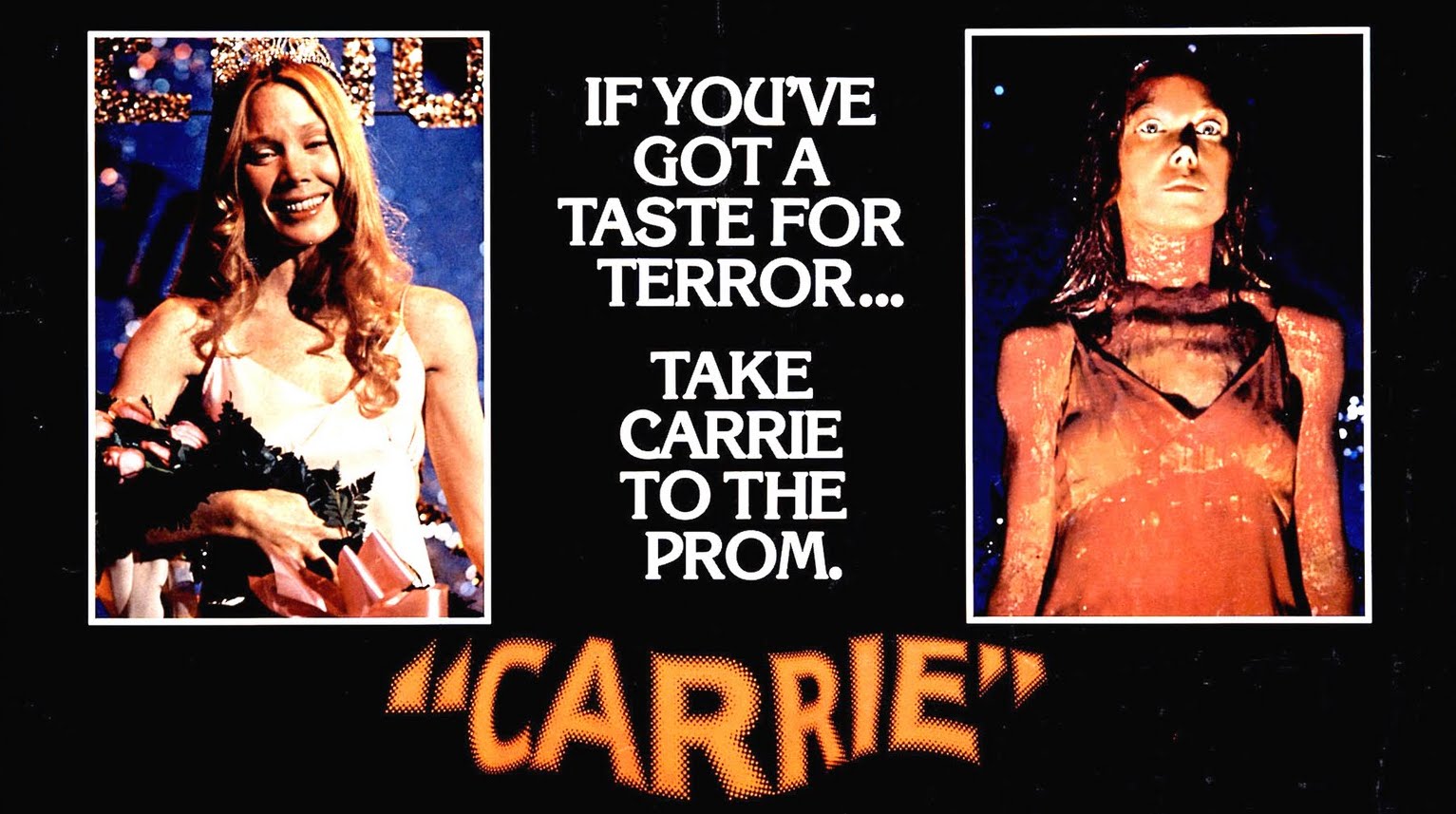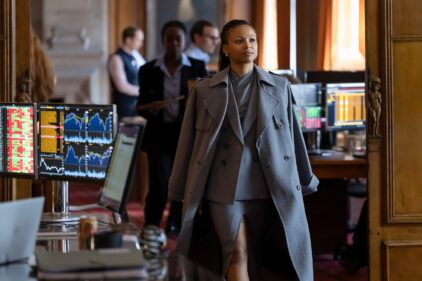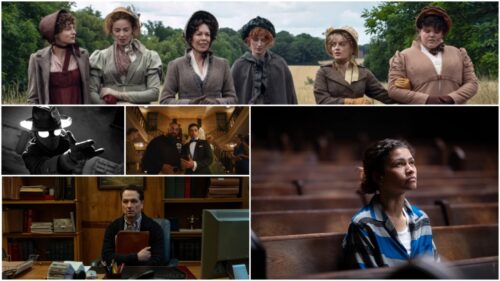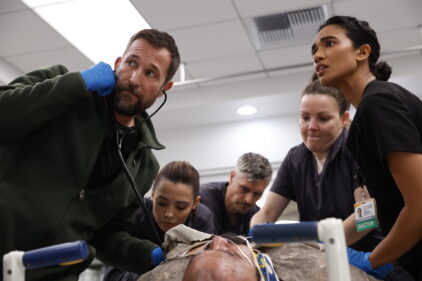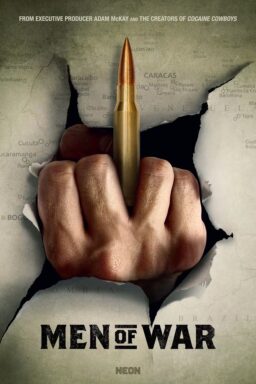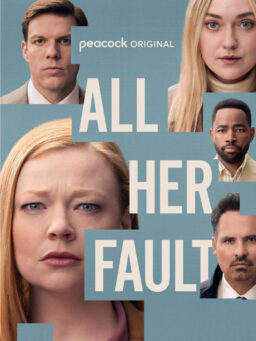When people write about Brian De Palma, they often take a moment to mention that he never quite managed to achieve the same level of commercial success as his contemporaries like Steven Spielberg, George Lucas and Martin Scorsese. It’s suggested that the reason for this is his preference for working with material that is darker, more disturbing and filled with lurid sex, gruesome violence and other audience-alienating elements. While true for the most part, this reasoning overlooks the fact that he’s had the occasional big success throughout his career and, unlike many idiosyncratic talents trying to make it through the Hollywood machine, with projects that allowed him to tap into the various themes and ideas that he had pursued throughout his career. “The Untouchables” (1987), for example, found him counterbalancing the usual cynicism of his work with unabashed crowd-pleasing heroics, which allowed him to deploy his flair for elaborate set pieces to boot; “Mission: Impossible” (1996) gave him the ability to explore ideas about voyeurism, technology and corruption within the framework of a Tom Cruise action vehicle. However, the most significant of his crossover hits was a relatively low-budget horror film, based on a modest-selling debut novel by a relatively unknown writer and featuring a cast consisting largely of up-and-coming actors that, to the surprise of everyone (especially the studio that financed and released it); it defied all possible expectations when it arrived in 1976, becoming a huge hit that would also give De Palma his first big box-office success. The film would earn two Oscar nominations (a rare feat for a genre film), launch the author of the original book, Stephen King, on his path to becoming one of the best-selling writers of all time and help revolutionize the entire horror movie genre.
That film, of course, is “Carrie” and to help mark—can it really be true?—its 40th anniversary on November 3, Shout! Factory has reissued the film on Blu-ray in a new edition that offers viewers a 4K transfer from the original negative and a slew of special features, both old and new, that tell the story of the film. “Carrie” is certainly deserving of such enshrinement—its twin standings as a genre classic and a pop culture touchstone have been solidified for decades now. But to watch it today is to realize that rather than coming across as some kind of museum piece whose power to shock has inevitably been dulled by the passing of time and the shifting of audience attitudes, “Carrie,” with the exception of a sartorial faux pas or two, is a masterful work of pure cinema. It is as fresh, vital and in tune with the times nowadays as it was back in the day. In fact, I would go so far as to say that “Carrie” expresses more about what is happening in the world today than practically any movie to be released by a major studio so far this year, regardless of genre.
Over the course of the decade preceding his involvement with “Carrie,” Brian De Palma had already been through the kind of up-and-down professional trajectory that would come to define his entire career. He first made a name for himself with the ultra-low-budget independent films as “Greetings” (1968) and “Hi Mom!” (1970), provocative anti-establishment comedies that did well at the box-office and earned him the attention of Hollywood, who wanted him to move up to the big leagues and do that kind of film for them, albeit on their terms. Unfortunately for De Palma, the end result of his first foray into studio filmmaking, “Get to Know Your Rabbit” (1972), was pretty much a disaster for everyone involved with it—his version was reedited by the studio over his objections and then flopped with critics and audiences alike when it was finally tossed out into theaters after a long delay. He quickly reestablished himself with the low-budget horror hit “Sisters” (1973) but when he followed that up with his delirious horror/musical-comedy hybrid “Phantom of the Paradise” (1974), that film inexplicably bombed, though it would go on to become a cult favorite. Then came “Obsession,” a blatant riff on “Vertigo” that he did in collaboration with Paul Schrader. and while the end result of that film was a modest success with audiences, it was the source of eventual strife with Schrader over the script and sat on a shelf for a long time before it finally came out. As a result, De Palma was not exactly the hottest of directors when “Carrie” came around. But when he got a look at it, he was instantly enamored of the cinematic possibilities it offered and essentially begged United Artists to direct it. (Although I cannot imagine there is anyone reading this who is not intimately familiar with the story, a brief recap follows. If you haven’t seen it, be advised that A.) there are spoilers and B.) you should stop reading this and see it right now—it will still be here when you are done.)

The story in question revolves around Carrie White, a shy outcast teenager who is either ignored or cruelly mocked by her classmates. After gym class one day, she is taking a shower when she has her first period. Having no idea of what is happening, for reasons that will inevitably become clear, she understandably freaks out. Led on by class Mean Girl Chris, the other girls begin mocking her terror and then start pelting her with tampons until their gym teacher comes in and puts a stop to it. Carrie’s apparent ignorance regarding menstruation springs from being raised by her religious fanatic mother Margaret, a cruel and domineering type who believes that just about everything under the sun is a sin and treats her daughter just as cruelly as her classmates.
Sue Snell, a basically decent girl who took part in the shower incident and who is now wracked with guilt over her actions, hits upon a way that she thinks will at least partially make things up to Carrie—she will forgo attending the upcoming prom and convinces her boyfriend, hunky heartthrob Tommy, to take Carrie instead. When Chris, who has been barred from prom at all for her actions, hears about Sue’s plan, she and her boyfriend, borderline hood Billy, devise their own far more insidious plan by rigging the voting with her friends so that Carrie and Tommy are elected Prom King and Queen as a prelude to an unimaginable public humiliation. The unsuspecting Carrie defies her mother and agrees to go with Tommy and has a magical night up until the moment when she mounts the stage to be crowned Prom Queen and Chris pulls off her cruel prank. Alas, what Chris and the other students, whom a now-crazed Carrie wrongly believes are laughing at her latest misfortune, do not realize is that she possess incredible telekinetic powers, which Carrie finally unleashes on her tormentors with gruesome results before heading home and confronting her mother one last time.
As laid out by King in his novel, “Carrie” contained a great story premise. It was an effective first run at the mixture of traditional horror concepts and everyday Americana that began with such popular titles as “Rosemary’s Baby” and “The Exorcist,” and which King would grow to be a master of over time. The flaw with King’s version is that the narrative framework that he employed—materials pertaining to a government commission regarding Carrie White that were interspersed throughout—was a gambit that, at least to these contemporary eyes, just doesn’t quite pay off. It has the effect of keeping readers at a certain distance from the story instead of fully enveloping them; it also has the odd effect of making Sue, the chief witness, into a more central character than the one that the book was named after. While penning the first draft of the screenplay, writer Lawrence D. Cohen stuck fairly close to the book and in fact retained the government commission framework. De Palma rejected this approach and elected instead to eliminate that structure and tell the story in a completely linear fashion—a slightly ironic move considering all the oddball narrative hurdles that he would throw at viewers in his later films. Cohen did a more straightforward version for his second draft and it was this one that, with a few minor changes here and there, De Palma wound up shooting. Over the years, many have tried to adapt King’s novels to the screen by changing things around in order to make them more cinematic but this is one of the few times when it has really worked—by disregarding the novel’s framework, viewers are drawn more immediately into the story and able to develop an emotional connection with what is going on that pays off in spades in the nightmarish final scenes. It works so well that I suspect when people think of “Carrie”’s story today, they immediately leap to the film as opposed to the book. And if someone comes to the novel after seeing the film, they are no doubt surprised and perhaps a tad annoyed with the additional stuff.

Another significant deviation from the novel came in regards to the handling of the character of Carrie herself. In the book, King depicted her as kind of a schlump throughout. While it was easy enough to empathize with her in the face of the unrelenting cruelties she faces at home and at school—most of us probably spent some part of our high school years feeling as awkward and alone as her—there was nothing about her that was especially likable or memorable other than her hidden paranormal abilities. De Palma hit upon the idea of depicting Carrie as a girl who could look dowdy and frumpy but who could also blossom into a genuine, if unconventional, beauty after being treated for once with something resembling kindness. To De Palma’s way of thinking, this approach might make it easier for audiences to accept the character as a person and thereby become more invested in what happens to her as the story progresses. Although it seems impossible to believe now, Sissy Spacek, who already had her stunning performance in Terrence Malick’s “Badlands” under her belt and who had actually helped her husband, Jack Fisk, create the sets for “Phantom of the Paradise,” was not his initial choice for the role—in fact, he was more interested in casting her as Chris (for Carrie, some have suggested that he was thinking about future Nancy Drew Pamela Sue Anderson). De Palma was only convinced otherwise when Spacek showed up to read after dressing in an especially homely manner and greasing her hair down with Vaseline.
Most of the other parts were cast through a series of auditions that De Palma held in conjunction with George Lucas, who was at the time casting “Star Wars.” Although this would result in some intriguing examples of potential alternative casting—Carrie Fisher and Melanie Griffith were apparently among the many who read for the title role—most parts went to newcomers who would all prove to be ideal for their roles. As Sue, Amy Irving made her big screen debut and her real-life mother, Priscilla Pointer, was given the role of her onscreen mother as well. In another example of real and reel life coinciding, William Katt, whom Irving had briefly dated in real life, was given the part of Tommy, Sue’s well-intentioned and ultimately doomed boyfriend. Nancy Allen, who had made her debut a couple of years earlier in “The Last Detail” (1973) landed the role of uber-bitch Chris and would eventually begin a relationship with De Palma that would extend into marriage (which would end in 1983) and appearances in his subsequent films “Home Movies” (1979), “Dressed to Kill” (1980) and “Blow Out” (1981) and future cult favorite P.J. Soles her gum-chewing, baseball cap-wearing pal Norma. Of the supporting roles, however, the two most significant hires would come outside of the audition process. To play the part of Margaret White, Piper Laurie came out of semi-retirement to make her first appearance on the big screen since being nominated for the Oscar for Best Actress for her work in “The Hustler” nearly fifteen years earlier. Finally, John Travolta, who was just beginning to make his ascension to stardom through his role on “Welcome Back, Kotter,” was brought in during his hiatus from the show to take on the role of Billy, who can only be described as the kind of guy that someone like Chris deserves to date.
Right from the very first sequence of the film, in which Carrie is mocked in gym class for blowing a play in a volleyball game before taking the most infamous screen shower since the one in “Psycho” (1960) (in a sly in-joke, the name of her school is Bates High), it is apparent we are in the hands of a master filmmaker and that this is not going to be just another run-of-the-mill exploitation film. There have been any number of high school films that have contained scenes set in the girls locker room that oftentimes exist only to provide young male viewers—the presumed target audience for this sort of film—with an acceptable amount of T&A. At first blush, as the camera passes through the throng of naked girls in slow-motion, that is what seems to be going on here but there is so much of it on display that it begins to get a little unsettling. By turning the dream of most adolescent boys into something bordering on the nightmarish, De Palma takes King’s gift for taking time-honored horror concepts and resettling them in ordinary, relatable surroundings and goes one further by injecting a dose of pure surrealism into that normalcy, before rudely shocking viewers into a truly realistic nightmare with Carrie’s discovery of her period and the fury in which the classmates who already deem her to be a freak turn on her over perhaps one of the very few things that they all actually have in common. The sequence is so charged that even though it also introduces the first example of Carrie’s powers as well (an exploding light bulb), that element hardly even registers on a first viewing.
The sequence is a stunner but it would inevitably lead to accusations of De Palma being a misogynist, a charge that he has had to defend himself against throughout much of his career. There are any number of reasons as to why I disagree with that particular charge, both in regards to his career as a whole and in the specific case of this film. For starters, one only has to look at his filmography to see that many of his most interesting films—such as this one, “Dressed to Kill,” “Body Double,” “Femme Fatale” and “Passion” (which essentially transposes the behavioral observations of “Carrie” from the classroom to the boardroom)—are ones that have been centered around female characters and where the male characters are the flawed and frail types who tend to get shoved to the background. That is especially true in the case of “Carrie,” in which the women seem to dominate over everything and where the men are either largely decorative (Tommy and Billy) or ineffectual despite their theoretical positions of authority. As for De Palma presenting the girls in such an unflattering light with their hazing of Carrie as some kind of indication that he views them as being monstrous, that is because they are supposed to be monstrous in that moment and to ease up on that at all would fail to let us fully understand the shame and humiliation that Carrie is undergoing in that moment. To do anything less would be to do an enormous disservice to the material, as anyone who saw the 2013 remake (directed by a woman, Kimberly Peirce) can sadly attest.

A sequence even half as visually dazzling and thematically rich as this opening would no doubt be considered the unassailable peak of most movies lucky enough to contain it. But De Palma manages to equal it with the infamous prom set piece that takes up about 25 minutes of screen time (nearly a third of the film’s entire running time) and makes every single one of them count. By this point in the proceedings, even those who have never read the book or seen the film before should be able to more or less guess that something bad is going to happen to Carrie and that she is going to reply in kind. For one of the great visual stylists of cinema, this stretch of narrative gave De Palma license to fully deploy the array of cinematic tricks in his arsenal—slow-motion, split-screen photography, extended tracking shots, rapid-fire editing, a bold color design in which blue, white and eventually, red dominate, lurid close-ups, extended tracking shots, moments of misdirection and deliberately disorienting moments ranging from a cheerfully romantic one in which Carrie and Tommy do a slow 360-degree spin on the dance floor one way while the camera follows it from the opposite direction, to the creepy one where Carrie begins to enact her revenge and we soon begin to look at her for the first time as a horrific figure and her classmates as those to be pitied. This may sound like overkill in theory (even De Palma has suggested a certain dissatisfaction with the use of split-screen in some interviews) but it is an incredible pleasure to observe how all this disparate elements come together to chart Carrie’s prom experience from the early moments of romantic fantasy to the eventual carnage with the precision and inevitability of a bad dream come to life.
This is not to suggest in any way that one spends the time in between those two sequences marking time waiting for the carnage to kick in. Instead, viewers get to spend that time watching something that they rarely get a chance to experience in films of this particular genre—fascinating characters brought to life by a gallery of wonderful performances. As Carrie, Sissy Spacek delivers the greatest performance in a career that has been filled with them. Although technically a few years too old to theoretically play a high school student, she somehow transforms herself into one that we can recognize from our own school years—the one whose shy and retiring nature inexplicably brings out the worst in some people and who could actually one day blossom if ever given the chance to do so. Unlike the Carrie of the book, we fully sympathize with her from the beginning and understand that she is not inherently a monster but one that has been created by others who nevertheless have failed to reckon with her power. At the same time, when she finally is pushed too far, we fear her as well because we know exactly what she is capable of and cringe as she is consumed by her hatred and madness, even if her reasons are fully understandable. This is one of the great performances in the entire history of the horror film and while it was a tribute to her work that it was acknowledged with an Oscar nomination, the fact that it didn’t win is one of the great injustices in the history of the Academy.
With a performance like Spacek’s at the center, “Carrie” could have easily come off as a one-woman show but she was surrounded by a bunch of nifty supporting performances that help to further enhance the proceedings. As Margaret White, Piper Laurie does an equally stunning job of presenting her character as a twisted mirror image of Carrie who starts off as monstrous as can be only to become more pathetic than anything else until going completely psychotic in time for their operatic final confrontation. (Laurie would also receive an Oscar nomination for Supporting Actress and would find her acting career as a result of her appearance here.) Amy Irving and William Katt both do a good job of keeping their characters from becoming the bland goody-goody types that they might have otherwise become. As their evil twins in the high school pecking order, Nancy Allen and John Travolta pull off the even more impressive trick of making their characters as irredeemably rotten as can be throughout the film while at the same time making them legitimately fun and funny to watch as well—the sheer delight that they take in their shared malevolence is a blast to watch.
Then there is De Palma, who conducts the proceedings with the kind of self-confidence in his artistic gifts that few filmmakers manage to achieve in their entire careers. Over the years, he has proven to be one of the most divisive of American filmmakers but this is perhaps the one film of his that everyone, regardless of where they stand on his career as a whole, seems to admire. Even though he obviously didn’t come up with the story himself, he has such a handle on what he wants to say with it and how to say it that “Carrie” feels just as personal as any of his self-generated projects. He effortlessly taps into our collective memories of the actual high school experience—oftentimes far removed from the version put forth in the kind of dumb movies that he definitively rebukes here—and uses them to both inform the story and help us embrace Carrie in a way that not even King was able to completely pull off in the book. At the same time, he again demonstrates his mastery of audience manipulation by first getting viewers completely on Carrie’s side and then eventually putting them in the discomfiting positions of A.) anticipating the sight of her prom night humiliation and B.) watching the person they have grown to like slaughtering all her classmates afterwards, even though many of them have themselves done nothing to deserve such retribution. (In fact, the grisliest death in the sequence is the one suffered by the gym teacher, who had done nothing except try to help Carrie out, even though her actions would play an inadvertent part in the horrors to come.) He is so much at the top of his game here that even if you have seen the film a number of times before, he still manages to suck you into the story to such a degree that you can still be caught off-guard by the proceedings. Then, just when you think that it is over, he comes up with one final shock (one not in the book) that not only supplies one of the great jump scares in film history but brilliantly subverts the hoary cliche that everything can go back to normal once the monster is defeated—here, even if you manage to survive everything, you still don’t get out of it completely unscarred.
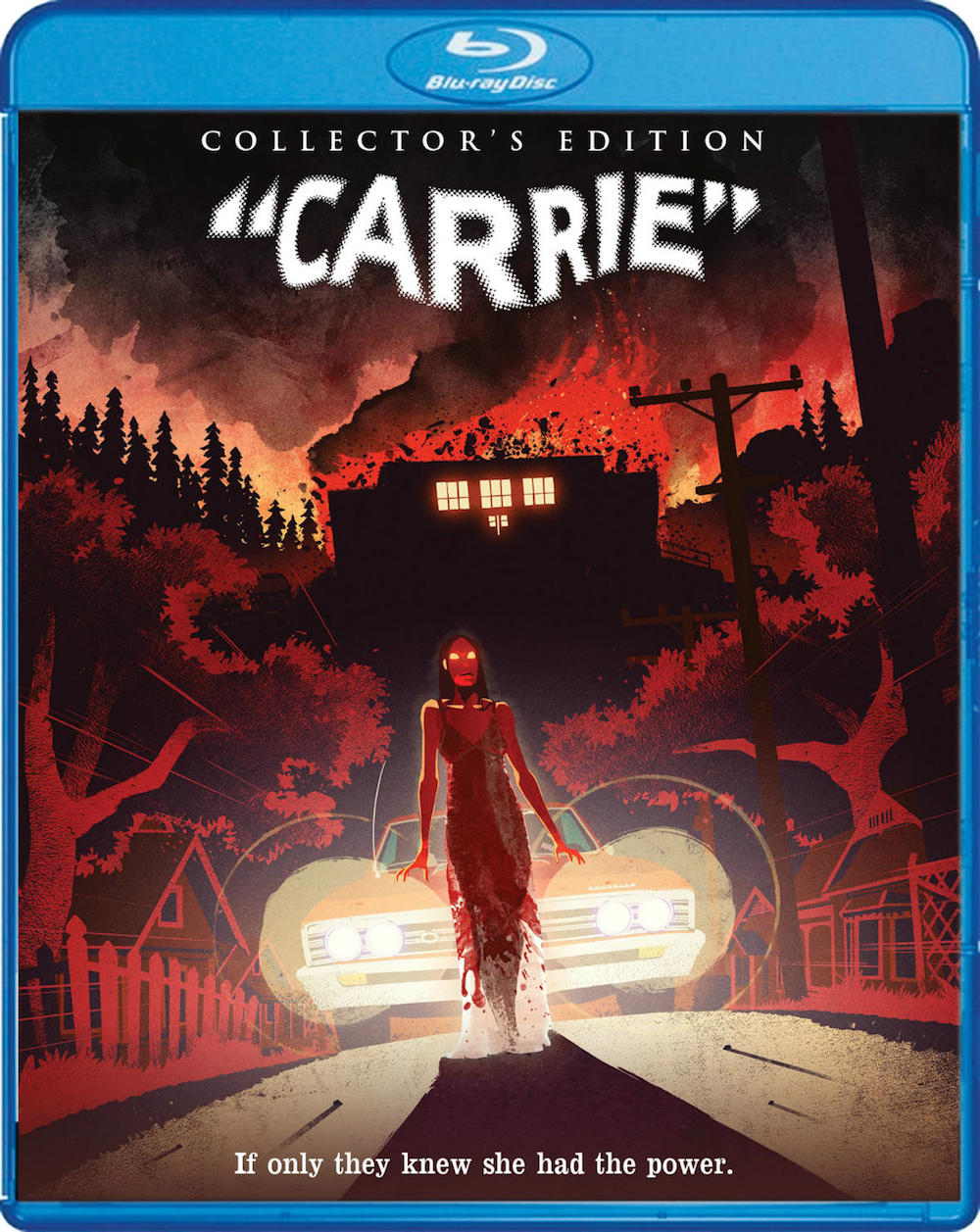
What makes “Carrie” especially compelling to watch today, more so than many other horror films from the era when it first came out, is that the thematic issues are just as relevant today as they were in 1976, if not more so. Many have read “Carrie” as an examination of feminism and the fear that some people have about what could happen when women finally tap into the power that they had been culturally conditioned to ignore for so many years. That fear seems to have returned into the collective consciousness in recent years, between attempts to roll back abortion rights and the frankly sexist reaction that many have had over the mere possibility of electing our first female president. Likewise, while it was a topic that was not discussed widely 40 years ago, the topic of bullying has become a part of the national discussion and by illustrating both the problem in grimly realistic term and, more fancifully, what can happen when victims are finally pushed too far, the film now feels startling in its prescience. Oddly enough, even though “Carrie” would go on to spawn two dismal remakes (a 2002 TV movie that felt more like a busted pilot and the aforementioned 2013 craptacular), a patently unnecessary 1999 sequel, an infamously failed Broadway musical adaptation and dozens of ripoffs over the years, none of them would come close to achieving the kind of social and cultural relevance the original maintains to this day.
As for the Blu-ray itself, Shout! Factory has put together a lavish two-disc set that collects both old and new special features into what should stand as the definitive version of the film for the foreseeable future. The first disc contains a good-looking 4K transfer of the original negative that helps to highlight the beautiful cinematography by Mario Tosi and a collection of trailers from all the films in what the packaging describes as the “Carrie Franchise.” On the second disc, Shout! Factory has included the bonus features from the previously released version—including separate featurettes on the acting and production sides of the film featuring interviews with De Palma, Spacek, Irving, Allen, Laurie, Cohen and others, a collection of TV and radio ads, behind-the-scenes stills and a brief look at the ill-fated Broadway musical adaptation—with new interviews with many of the participants of the earlier featurettes (though De Palma and Spacek apparently sat out of this round) along with the likes of Tosi and composer Pino Donaggio, whose began a long and fruitful collaboration with De Palma with this film, and a video guided tour of the locations where the film was shot. Coming out just in time for Halloween, the film may have a mean trick at its center but this Collector’s Edition of “Carrie” is nothing but a pure treat.
“Carrie” is available in a new Collector’s Edition Blu-ray from Shout! Factory on October 11. To order your copy, click here.

